|
Battle of Malvern Hill, Virginia
Malvern Hill Civil War History
Battle of Malvern Hill
Other Names: Battle of Poindexter’s Farm
Location: Henrico County
Campaign: Peninsula Campaign (March-July 1862)
Date(s): July 1, 1862
Principal Commanders: Maj. Gen. George B. McClellan [US]; Gen. Robert E. Lee [CS]
Forces Engaged: Armies
Estimated Casualties: 8,500 total
Result(s): Union victory
| Civil War Battle of Malvern Hill Map |
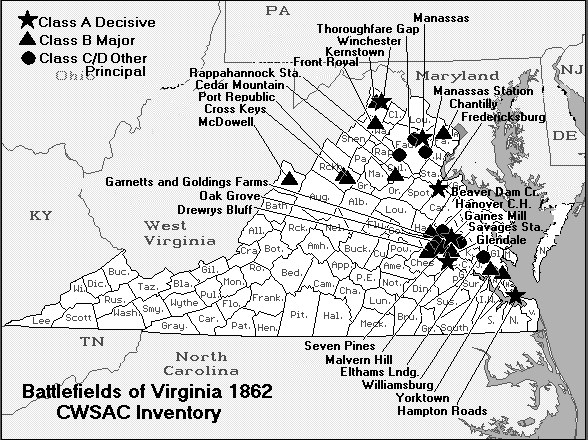
|
| Battle of Malvern Hill, Virginia, Map |
Description: The Battle of Malvern Hill, also known as the Battle
of Poindexter's Farm, was the sixth and last of the Seven Days Battles. On July 1, 1862, Gen. Robert E. Lee launched
a series of disjointed assaults on the nearly impregnable Union position on Malvern Hill. The Confederates suffered more than
5,300 casualties without gaining an inch of ground. Despite his victory, McClellan withdrew to entrench at Harrison’s
Landing on James River, where his army was protected by gunboats. This ended the Peninsula Campaign. When McClellan’s army ceased to threaten Richmond, Lee sent Jackson
to operate against Maj. Gen. John Pope’s army along the Rapidan River, thus initiating the Northern Virginia Campaign.
"[Malvern Hill] wasn't war; it was murder." Confederate Maj. Gen. D. H. Hill.
Setting the Stage: The second phase of the Peninsula
Campaign, consequently, took a negative turn for the Union when Lee launched fierce counterattacks just east of Richmond in the Seven Days Battles (June 25–July 1, 1862). Although they are formally considered part of
the Peninsula Campaign, the final battles of June 25 to July 1, with Lee in command and on the offensive against McClellan,
are popularly known as the Seven Days Battles.
The final battle of the Seven Days was the first in which the Union Army
occupied favorable ground. For the preceding six days, McClellan's Army of the Potomac had been retreating to the safety of
the James River, pursued by Lee's Army of Northern Virginia. Up to this point, the major battles of the Seven Days had been
mostly inconclusive, but McClellan was unnerved by Lee's aggressive assaults and remained convinced that he was seriously
outnumbered, although in fact the two armies were roughly equal.
Malvern Hill offered good observation and artillery positions, having been
prepared the previous day by the V Corps, under Brig. Gen. Fitz John Porter. McClellan himself was not present on the battlefield,
having preceded his army to Harrison's Landing on the James, and Porter was the most senior of the corps commanders. The slopes
were cleared of timber, providing great visibility, and the open fields to the north could be swept by deadly fire from the
250 guns placed by Col. Henry J. Hunt, McClellan's chief of artillery. Three gunboats on the James River, the USS Galena,
USS Jacob Bell, and USS Aroostook, added even more firepower. Beyond this space, the terrain was swampy and thickly wooded.
| Civil War Seven Days Battles Map |
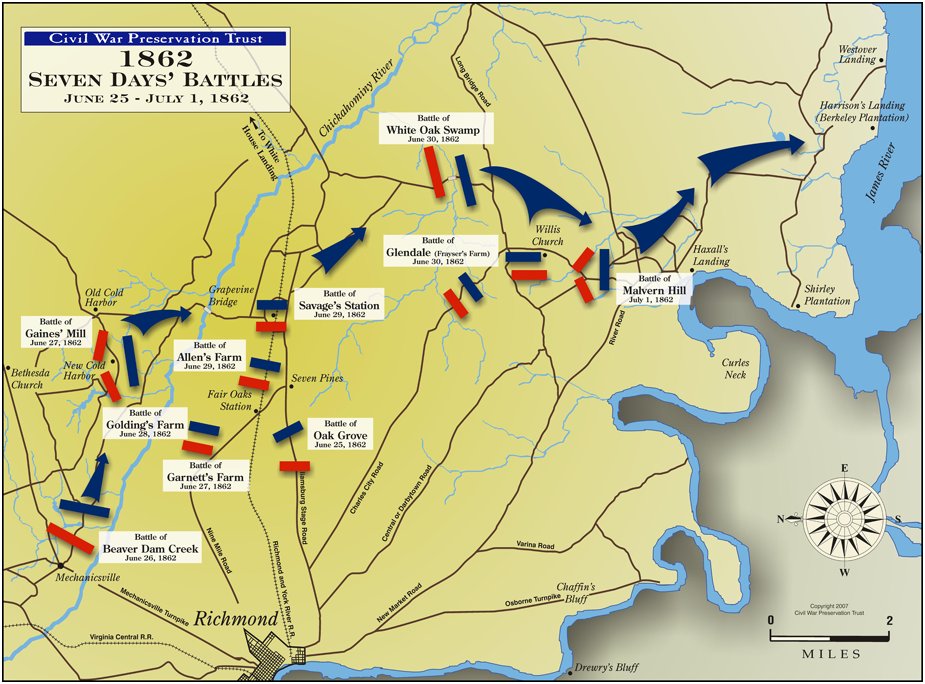
|
| Civil War Battle of Malvern Hill Map |
The entire Army of the Potomac occupied the hill, with the exception of
Brig. Gen. Silas Casey's Division, now commanded by Brig. Gen. John J. Peck, of the IV Corps, which had proceeded to Harrison's
Landing and, while not engaged, formed the extreme right of the Federal line. The Federal line extended in a vast semicircle
from Harrison's Landing on the extreme right to Brig. Gen. George W. Morell's division of Porter's Corps on the extreme left,
which occupied the geographically advantageous ground on the northwestern slopes of the hill. Adjoining the right of Morell's
command was Brig. Gen. Darius N. Couch's division, which had been detached from the IV Corps, now at Harrison's Landing, and
occupied the effective center of the Federal position. Although Porter commanded the portion of the field on which Couch's
troops were positioned, he elected to allow Couch to act in command independently, not bringing his detached division under
the command of one of the other corps commanders. Extending the Federal line on Couch's right were the divisions of Brig.
Gens. Philip Kearny and Joseph Hooker of Brig. Gen. Samuel P. Heintzelman's III Corps. To the right was Brig. Gen. Edwin Vose
Sumner's II Corps, consisting of the divisions of Brig. Gens. Israel B. Richardson and John Sedgwick, which were anchored
to Peck's Division of the IV Corps at Harrison's Landing. For the most part however, the Union infantry were passive spectators
in the battle.
Rather than flanking the position, Lee attacked it directly, hoping
that his artillery would clear the way for a successful infantry assault (just as he would plan the following year in Pickett's
Charge at Gettysburg). He also believed that his soldiers were in better fighting shape than their Union counterparts, despite
the six preceding days of hard fighting and marching. (A number of the Union Corps had in fact not yet participated in direct
combat.) Lee's plan was to attack the hill from the north on the Quaker Road, using the divisions of Maj. Gens. Thomas J.
"Stonewall" Jackson, Richard S. Ewell, D. H. Hill, and Brig. Gen. William H. C. Whiting. Maj. Gen. John B. Magruder was ordered
to follow Jackson and deploy to his right when he reached the battlefield. Maj. Gen. Benjamin Huger's division was to follow
as well, but Lee reserved the right to position him based on developments. The divisions of Maj. Gens. James Longstreet and
A. P. Hill, which had been the most heavily engaged in the Battle of Glendale the previous day, were held in reserve. Seeing
how strong the Union position was, D. H. Hill opposed the idea of a direct attack, but Lee was confident that one final push
would work.
| Battle of Malvern Hill Map |
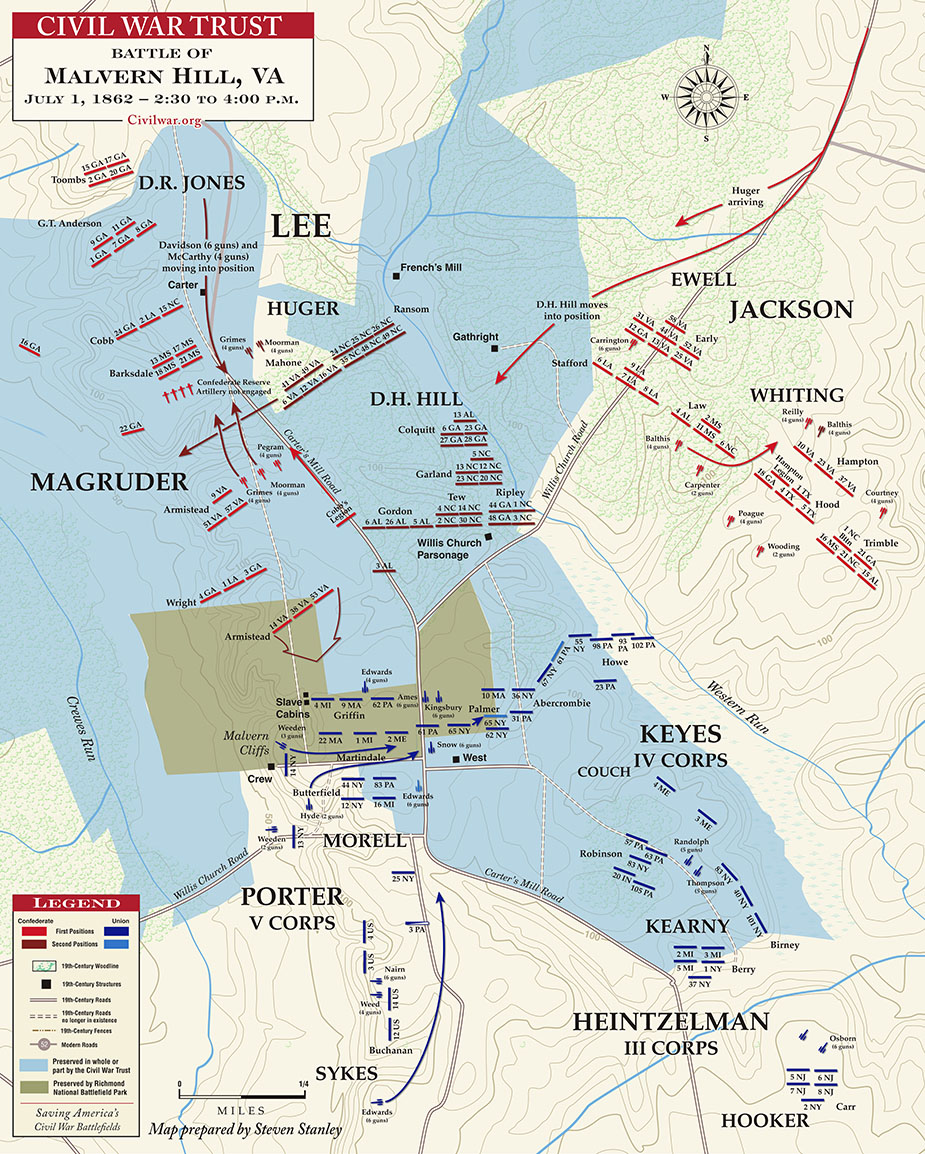
|
| Civil War Battle of Malvern Hill Battlefield Map |
| Malvern Hill and Seven Days Battles Map |
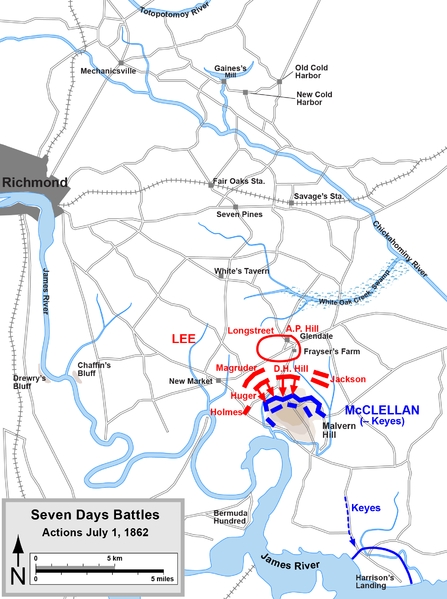
|
| Civil War Battle of Malvern Hill History Map |
Battle: As with most of the battles in the Seven
Days, Lee's complex plan was poorly executed. The approaching soldiers were delayed by severely muddy roads and poor maps.
Jackson arrived at the swampy creek called Western Run and stopped abruptly. Magruder's guides mistakenly sent him on the
Long Bridge Road to the southwest, away from the battlefield. Eventually the battle line was assembled with Huger's division
(brigades of Brig. Gens. Ambrose R. Wright and Lewis A. Armistead) on the Confederate right and D. H. Hill's division (brigades
of Brig. Gen. John Bell Hood and Col. Evander M. Law) on the Quaker Road to the left. They awaited the Confederate bombardment
before attacking.
Unfortunately for Lee, Henry Hunt struck first, launching one of the
greatest artillery barrages in the war from 1 p.m. to 2:30 p.m. The Union gunners had superior equipment and expertise and
disabled most of the Confederate batteries, which were concentrated on a hill 1,200 yards north of the Crew House and at Poindexter's
farm to the northeast. The advancing columns of Confederate infantry were blasted to pieces by the massed artillery. Even
more terrifying were the huge 50-pound shells lobbed from the three gunboats. Despite the setback, Lee sent his infantry forward
at 3:30 p.m. and Armistead's brigade made some progress through lines of Union sharpshooters. By 4 p.m., Magruder arrived
and he was ordered forward to support Armistead. His attack was piecemeal and poorly organized.
Meanwhile, D. H. Hill launched his division forward along the Quaker Road,
past Willis Church. Across the entire line of battle, the Confederate troops reached only within 200 yards of the Union Center
and were repulsed by nightfall with heavy losses. As the sun was going down, Brig. General Isaac Trimble of Ewell's division
began to move his troops forward. Jackson stopped him and asked "What are you going to do?" Trimble replied, "I'm going to
charge those batteries, sir!" "I guess you'd better not try it." Jackson said. "General [D.H.] Hill has just tried with his
entire division and been repulsed. I guess you'd better not try it." See also Malvern Hill: A Civil War History.
Malvern Hill ended the Peninsula Campaign. When McClellan's army ceased
to threaten Richmond, Lee sent Jackson to operate against Maj. Gen. John Pope's army along the Rapidan River, thus initiating
the Northern Virginia Campaign. After reporting to the Union authorities in Washington that a further advance on Richmond
was hopeless, McClellan's army was slowly transferred to northern Virginia to reinforce Pope. See also Civil War Peninsula Campaign
and Seven Days Battles, Virginia.
| Battle of Malvern Hill |
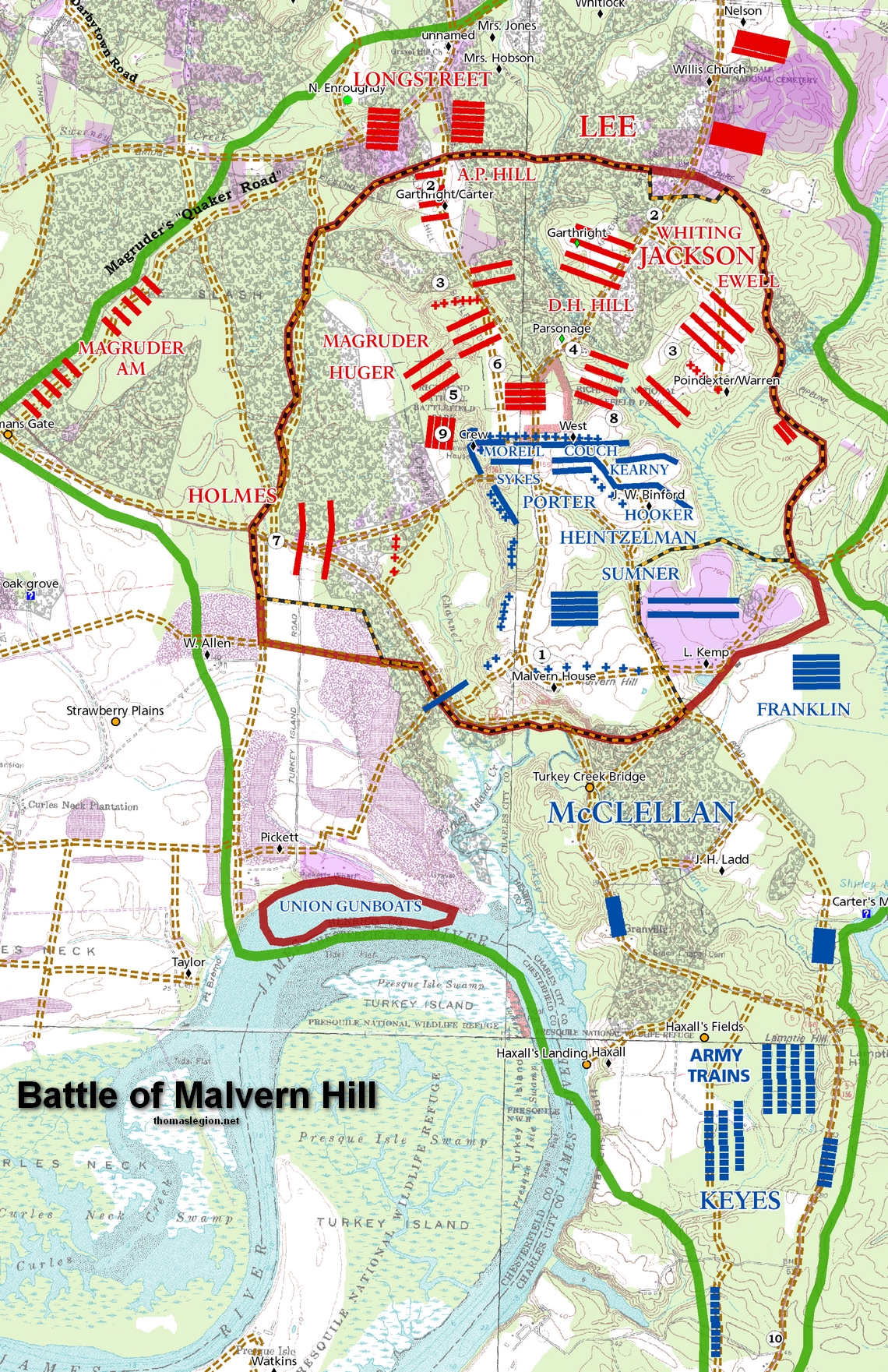
|
| Malvern Battlefield on July 1, 1862 |

|
| Battle of Malvern Hill Key |
Legend: 1) The retreating US Army of nearly 80,000 strong took a defensive position on Malvern Hill during
the night of June 30. Morning of July 1, Maj. Gen. Porter oversaw deployment of infantry and 1000 pieces of artillery. 150
guns were in reserve near the Malvern House. 2) Gen. Lee's Confederate divisions (about 70,000 men) advanced on converging
roads and came under artillery fire as they began deploying in the woods. 3) Maj. Gen. Longstreet proposed establishing two
grand Confederate batteries (on the right of 60 guns and on the left 30 guns) to take the Federals in a cross-fire. 4) Lee
issued orders about 2 P.M. for a general assault if the Confederate artillery succeeded in suppressing the US guns. Only 20
Confederate guns got into action and these were soon silenced. 5) In the meantime, Brig. Gen. Armistead's brigade came under
heavy fire and acted to force back sharpshooters and skirmishers in their front, triggering the "general assault." 6) Maj.
Gen. Magruder, forced to countermarch after heading southwest on the wrong "Quaker Road," reached the front about 4:30 and
fed his brigades piecemeal into an existing attack. 7) As on the previous day, Maj. Gen. Holmes was unable to advance because
of the US gunboats. 8) About 6 P.M., Maj. Gen. D.H. Hill joined the action. His battle lines were cut to pieces by cannister,
but the soldiers held on for an hour of deadly combat, inflicting heavy casualties. 9) With fresh troops, Magruder launched
a final attack about dusk that briefly penetrated Union lines. His soldiers could not exploit the breakthrough. 10) During
the night, the Army of the Potomac completed its withdrawal to Harrison's Landing where Maj. Gen. McClellan established a
fortified enclave protected by naval gunboats.
| Battle of Malvern Hill, Virginia, Map |
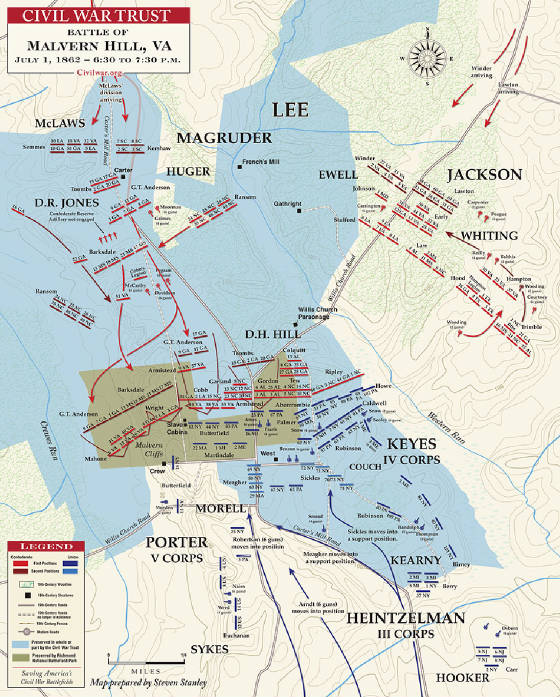
|
| Civil War Malvern Hill Battle |
| Malvern Hill Civil War Battle Map |
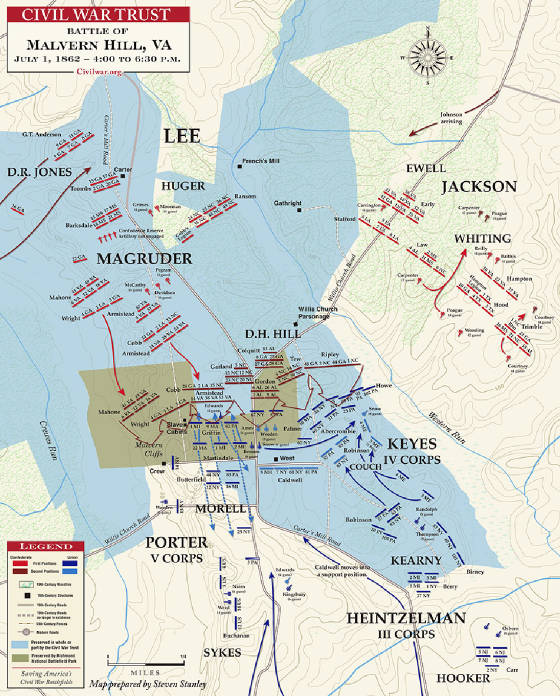
|
| Malvern Hill Battle Map |
Analysis: The Battle of Malvern Hill, also known as the Battle of Poindexter's Farm, was fought on July 1, 1862, in Henrico County, Virginia, on the seventh
and last day of the Seven Days Battles during the Peninsula Campaign of the American Civil War. Gen. Robert E. Lee launched
a series of disjointed assaults on the nearly impregnable Union position on Malvern Hill. The Confederates suffered more than
5,000 casualties without gaining an inch of ground. Despite his victory, Maj. Gen. George B. McClellan withdrew to entrench
at Harrison's Landing on the James River, where his army was protected by gunboats, ending the Peninsula Campaign.
The Battle of Malvern Hill was a resounding Union tactical victory. The victory was due in no small part to
Henry Hunt, the Union chief artillerist, who did proficient work in accumulating and concentrating the Union guns. Troop placement
before the battle by the army's principal topographical engineer, Col. A. A. Humphreys, was also carried out capably. The
ground on Malvern Hill was used effectively and the Union line had depth with a healthy amount of rested troops available
to defend it. Fitz John Porter, the de facto commander for the day, played an important role in this. He posted his men well
on June 30, and stationed reinforcements near to the Union line. Darius Couch, whose forces comprised half of the Union center,
positioned his reinforcements in good order as and in cooperation with George Morell, whose units formed the other part of
the Union middle. The infantrymen performed well also. As Brian K. Burton notes, "[the infantrymen] stayed behind the guns
most of the time and did not advance too far during countercharges. This behavior allowed the gunners a clear field of fire."
Furthermore, if more of anything was needed, infantry or artillery, it was available. At the forefront of the Union victory,
however, was the overwhelming firepower of their artillery, as later accounts by soldiers from both armies repeatedly attested.
A number of shortcomings in planning and execution contributed to the debacle suffered by the
Confederates. The Confederate brigade leaders performed well, with the exception of a few minor instances; Burton surmises
that the blame of July 1 must lie with the overall commanders. James Longstreet was overconfident about the artillery strategy,
which proved less effective than it could have been largely because both he and "Stonewall" Jackson had problems gathering
the artillery for the assault. The Confederate practice of moving artillery with individual units instead of in one mass and
the difficult terrain surrounding Malvern Hill contributed to this issue. A potential solution to this problem lay with Brig.
Gen. William N. Pendleton's fourteen batteries in reserve. However, Lee's headquarters never contacted Pendleton, who spent
July 1 "await[ing] events and orders, in readiness for whatever service might be called for." These orders never came, and
Pendleton's batteries went unused. Magruder might also share in the blame; his late arrival to the battlefield was caused
by bad maps and poor guides. Since Magruder received Chilton's draft late in the day, and with no time attached to it,
there was no way for him to determine the relevance of the order. Burton suggests that Magruder cannot be reasonably blamed
for his attacks on the Union line: he was responding to Lee's orders and did initially try to form a unified attack on the
Union line. Finally, Magruder was riding back and forth across the battlefield, making it difficult for him to be found by
junior officers seeking guidance. Several other factors may have played into the Confederate repulse, including Theophilus
Holmes's refusal to participate in the battle, dismissing any notion of actively engaging the enemy.
| Malvern Hill Civil War Virginia Battle Map |
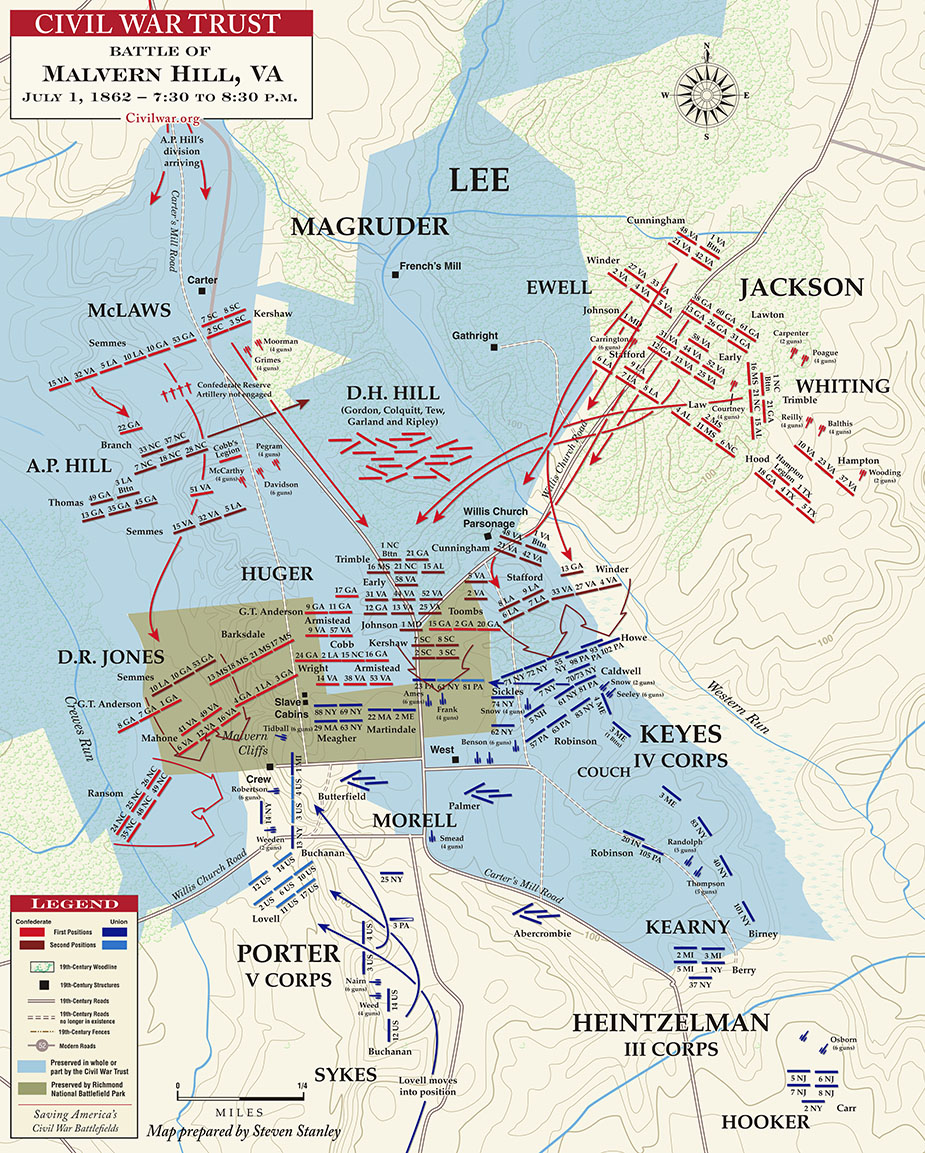
|
| Battle of Malvern Hill, VA, Map |
Lee's part in the Confederate defeat at Malvern Hill has been criticized by historians. Though he put rested
troops on the field and accepted Longstreet's suggestions, which did not commit him to a charge, Lee himself was not present
on the battlefield to observe the fighting. Historian Stephen Sears points out that Lee's ineffective communication with his
generals and apparent failure to write his own communications to his brigadier generals (instead leaving orders open to interpretation) may have contributed to the defeat. Lee could also have countermanded Chilton's
orders when it became apparent they were fruitless, or verified the "success" of Armistead. Consequently, Lee must also share
some blame in the repeated lack of coordination of attacks throughout the day. Perhaps stating it best was Maj. Gen. D. H.
Hill, who wrote in a postwar article that "It wasn't war; it was murder."
Despite the strength of Malvern Hill, as demonstrated in the battle, McClellan
felt he needed to continue with his planned withdrawal to Harrison's Landing, to Fitz John Porter's chagrin. Porter felt that
the Army of the Potomac should remain atop the hill or perhaps even continue their advance to Richmond. McClellan however
insisted that Confederate troops greatly outnumbered his own, felt he could not protect Harrison's Landing from his current
position at Malvern Hill, and feared being cut off from his supply depot. McClellan's mentality prevailed. The Union batteries
and McClellan's engineers began moving to Harrison's Landing soon after the end of the Battle of Malvern Hill. Starting at
about 11 p.m. unit after unit began to follow. Within hours, nearly all of McClellan's Army of the Potomac was marching towards
Harrison's Landing. Once the last of these men had crossed the Turkey Island Bridge, they destroyed the bridge and felled
trees over it to stymie any pursuit, leaving the James River between the Union and Confederate armies.
The areas around Malvern Hill hosted much of Lee's army the night after
the battle. Some of the Confederates were close enough to hear the sounds made by the Army of the Potomac retreating under
cover of darkness, and see the lanterns of Northerners helping their wounded. The day after the Battle of Malvern Hill, Lee
and "Stonewall" Jackson met President Jefferson Davis at Poindexter farm. They considered immediately pursuing McClellan;
however, in view of the rain and confusion, Davis and Lee deemed large-scale pursuit of McClellan's army too risky. Jackson
disagreed, saying, "They have not all got away if we go immediately after them." Jackson even had the bodies of the dead moved
so that his soldiers had a clear line of attack when pursuing McClellan. However, Davis and Lee thought it necessary to rest
the army. They did not completely rule out a pursuit though; Lee even ordered J. E. B. Stuart to reconnoiter McClellan's position
for future attacks. Lee ordered Theophilus Holmes to move to Drewry's Bluff, and decided to keep the men on Malvern Hill through
July 3 to forestall any potential Union attack against that location.
| 1862 Virginia Civil War Battlefields |
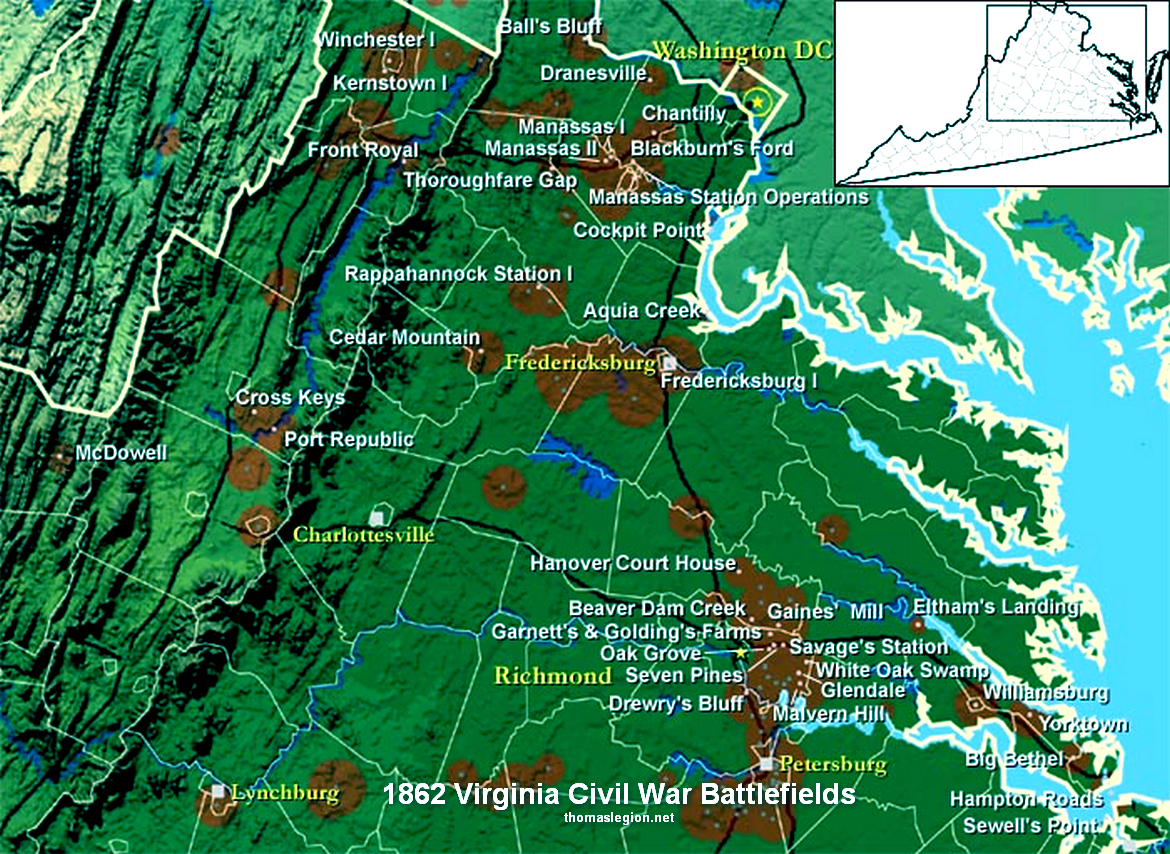
|
| Malvern Battlefield Map |
| Civil War Malvern Battlefield Map |
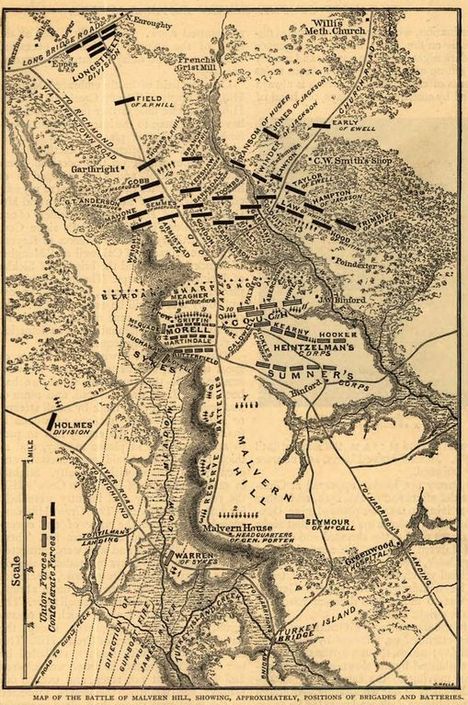
|
| Civil War Map of Malvern Army Positions |
| Order of Battle of Malvern Hill, Virginia, Map |
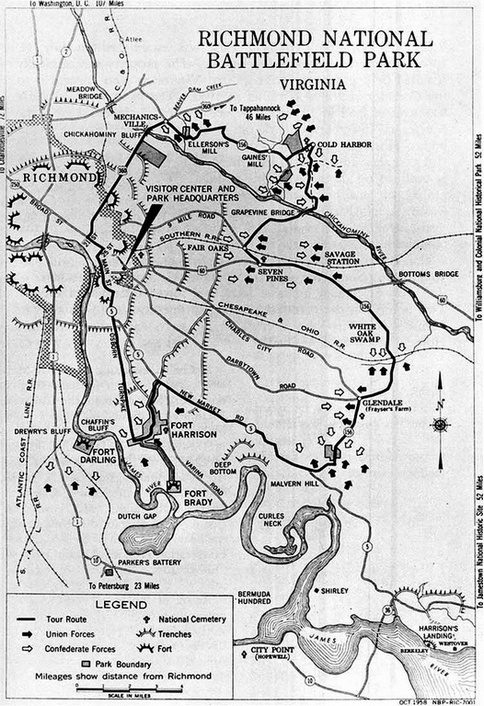
|
| Map of Union and Confederate Forces at Malvern Hill Battlefield |
On July 4, 1862, Lee's men began marching towards Harrison's Landing. He
made his headquarters a few miles north of Evelington Heights, a sixty-foot elevation approximately thirteen miles from Harrison's
Landing, and stayed nearby with his army for several days, searching for weaknesses in the Union line at the heights that
might allow for an attack. No weakness presented itself though, and by the end of July 8, the entire Army of Northern Virginia,
save for cavalry stations and picket forces, was back near Richmond. The Peninsula Campaign was over..
Despite the defeat on Malvern Hill, the Seven Days Battles accomplished the original Confederate goal of removing any direct threat to Richmond from the Union Army. The three
newspapers in Richmond exulted in this strategic victory and lionized Robert E. Lee as a national hero: "No captain that ever
lived," opined the Richmond Dispatch, "could have planned or executed a better plan." Similarly, Confederate Navy Secretary
Stephen Mallory said, "the Great McClelland [sic] the young Napoleon now like a whipped cur lies on the banks of the James
River crouched under his Gun Boats." Throughout Richmond and the once-beleaguered South, there was a triumphant mood, and
scant attention was paid to the flaws in Lee's tactics or execution.
Lee was not exultant, but "deeply, bitterly disappointed" at the result.
"Our success has not been as great or complete as we should have desired", Lee wrote to his wife. In his official report,
he wrote, "Under ordinary circumstances, the Federal Army should have been destroyed." The North Carolinian D. H. Hill shared
Lee's bitterness, and wrote that the "blood of North Carolina poured like water". In a post-war article he wrote that the
battle "was not war; it was murder." Lee did not distribute blame for the failure to reach his desired result, but there were
repercussions. Several commanders were reassigned, including Theophilus Holmes and John Magruder, and his army was reorganized
into two wings, one under "Stonewall" Jackson and another under James Longstreet.Further, Confederate artillery would now
be moved in battalion-sized units, at the head of Confederate columns.
In McClellan's case, his success on Malvern Hill was overshadowed by
his overall defeat in the Seven Days Battles. The Northern public met McClellan's defeat with despondency, and his reputation
was tarnished. Some of McClellan's soldiers voiced their continued confidence in him. Such opinions were not unanimous, however;
one of McClellan's engineers, Lt. William Folwell, wondered why "they deify a General whose greatest feat has been a masterly
retreat." A similar opinion was shared by many others in the rank and file of the Union military. Some in politics also abandoned
the Democratic McClellan. He was also accused of being on the Galena during the Battle of Malvern Hill, and newspapers and
tabloids around the country heaped scorn on him for this, especially when he ran for president in 1864. President Lincoln
was also losing faith in McClellan. On June 26, the day of Lee's first offensive during the Seven Days, the Army of Virginia
was formed and the command given to Maj. Gen. John Pope. While McClellan was at Harrison's Landing, parts of his Army of the
Potomac were continuously reassigned to Pope. Pope and his Army of Virginia left for Gordonsville, Virginia on July 14, setting
the stage for the subsequent Northern Virginia Campaign.
In his Battle-Pieces publication, Herman Melville penned a poem about the
battle, titled with the same name as the hill on which it was fought. In the poem, Melville questions the elms of Malvern
Hill of whether they recall "the haggard beards of blood" the day of the battle.
(Sources and related reading below.)
Recommended
Reading: To The Gates of Richmond: The Peninsula Campaign, by Stephen W. Sears. From Kirkus Reviews: In George B. McClellan
(1988) and his work editing the papers of the Union general, Sears established himself as the critical but indispensable authority
on flawed ``Little Mac.'' Now, in a stirring prequel to Landscape Turned Red (1983), his superb account of the Battle of Antietam,
the author reaffirms his mastery of historical narrative. In March 1862, the egotistical but timorous McClellan was prodded
by Lincoln into finally launching the first major offensive by the Army of the Potomac.
Instead of marching directly overland from Washington, McClellan used Federal sea power to
advance on Richmond by way of the peninsula between the York
and James Rivers. Continued below…
The ``Grand
Campaign,'' however, soon belied its creator's Napoleonic pretensions by becoming a three-and-a-half-month nightmare of feints
and pitched battles, ultimately engaging up to a combined quarter-million men on both sides and leaving one of every four
men dead, wounded, or missing. Using hundreds of eyewitness accounts, Sears demonstrates how the most creative use of military
technology (ironclad warships, 200-pounder rifled cannon, battlefield telegraph, and aerial reconnaissance) existed side by
side with the most appalling mismanagement (Stonewall Jackson's uncharacteristic lethargy; McClellan's mistaken belief that
the numerically inferior rebels possessed a two-to-one manpower advantage; out-of-sync attacks by both Confederate and Union
generals). Above all, though, Sears casts the campaign as a clash of wits and wills between McClellan--whom he accuses of
losing ``the courage to command''--and Robert E. Lee--who, upon succeeding the wounded Joseph E. Johnson as head of the Army
of Northern Virginia, seized the initiative, repulsed the assault in the series of ``Seven Days'' battles, and began his long
journey into legend. An authoritative, ironic, and stirring addition to Civil War annals. “…[No] serious study
of the Peninsula Campaign is possible without this book.” Americancivilwarhistory.org
Recommended
Reading: The Richmond Campaign of 1862: The Peninsula and the
Seven Days (Military Campaigns of the
Civil War). Description: The Richmond campaign of April-July
1862 ranks as one of the most important military operations of the first years of the American Civil War. Key political, diplomatic,
social, and military issues were at stake as Robert E. Lee and George B. McClellan faced off on the peninsula between the
York and James Rivers. The climactic clash came on June 26-July 1 in what became known as the Seven Days battles, when Lee,
newly appointed as commander of the Confederate forces, aggressively attacked the Union army. Casualties for the entire campaign
exceeded 50,000, more than 35,000 of whom fell during the Seven Days. Continued below…
This book offers nine essays in which well-known Civil War historians explore questions regarding
high command, strategy and tactics, the effects of the fighting upon politics and society both North and South, and the ways
in which emancipation figured in the campaign. The authors have consulted previously untapped manuscript sources and reinterpreted
more familiar evidence, sometimes focusing closely on the fighting around Richmond and sometimes looking more broadly at the background
and consequences of the campaign.
Recommended Reading: Extraordinary Circumstances: The Seven Days Battles (Library Binding). Description: EXTRAORDINARY CIRCUMSTANCES tells the story of the Seven Days Battles,
the first campaign in the Civil War in which Robert E. Lee led the Army of Northern Virginia. One of the most decisive military
campaigns in Western history, the Seven Days were fought in the area southeast of the Confederate capitol of Richmond from
June 25 to July 1, 1862--and began a string of events leading to the Emancipation Proclamation and the shift toward total
war.
Recommended Reading: The Fighting
Men of the Civil War, by William C. Davis (Author), Russ A. Pritchard (Author). Description: "A must for
any Civil War library!" The sweeping histories of the War Between the States often overlook the men in whose blood that history
was written. This account goes a long way toward redressing the balance in favor of the men in the ranks. The reader follows
the soldiers from enlistment and training to campaigning. Attention is also given to oft-forgotten groups such as the sailors
and black troops. Continued below...
No effort has
been spared to include rare war era photographs and color photos of rare artifacts. Engagingly written by William C. Davis,
the author of more than thirty books on the American Civil War. Award winning author and historian James M. McPherson states:
"The most readable, authoritative, and beautifully designed illustrated history
of the American Civil War."
Recommended
Reading: The Official Virginia Civil War Battlefield Guide. Review: This is one of the most useful guides I've ever read.
Virginia was host to nearly one-third of all Civil War engagements,
and this guide covers them all like a mini-history of the war. Unlike travel books that are organized geographically, this
guide organizes them chronologically. Each campaign is prefaced by a detailed overview, followed by concise (from 1 to 4 pages,
depending on the battle's importance) but engrossing descriptions of the individual engagements. Continued below…
These descriptions
make this a great book to browse through when you're not in the car. Most sites' summaries touch on their condition--whether
they're threatened by development (as too many are) and whether they're in private hands or protected by the park service.
But the maps are where this book really stands out. Each battle features a very clear map designating army positions and historical
roads, as well as historical markers (the author also wrote “A Guidebook to Virginia's Historical Markers”), parking, and visitors'
centers. Best of all, though, many battles are illustrated with paintings or photographs of the sites, and the point-of-view
of these pictures is marked on each map!
Recommended Viewing: The Civil War - A Film by Ken Burns. Review: The
Civil War - A Film by Ken Burns is the most successful public-television miniseries in American history. The 11-hour Civil War didn't just captivate a nation,
reteaching to us our history in narrative terms; it actually also invented a new film language taken from its creator. When
people describe documentaries using the "Ken Burns approach," its style is understood: voice-over narrators reading letters
and documents dramatically and stating the writer's name at their conclusion, fresh live footage of places juxtaposed with
still images (photographs, paintings, maps, prints), anecdotal interviews, and romantic musical scores taken from the era
he depicts. Continued below...
The Civil War uses all of these devices to evoke atmosphere and resurrect an event that many knew
only from stale history books. While Burns is a historian, a researcher, and a documentarian, he's above all a gifted storyteller,
and it's his narrative powers that give this chronicle its beauty, overwhelming emotion, and devastating horror. Using the
words of old letters, eloquently read by a variety of celebrities, the stories of historians like Shelby Foote and rare, stained
photos, Burns allows us not only to relearn and finally understand our history, but also to feel and experience it. "Hailed
as a film masterpiece and landmark in historical storytelling." "[S]hould be a requirement for every
student."
Sources: National Park Service; National Archives; Library of Congress;
Official Records of the Union and Confederate Armies; Civil War Trust, civilwar.org; Abbot, Henry L. (2010). Siege Artillery
in the Campaigns Against Richmond: With Notes on the Fifteen-Inch Gun. Ann Arbor, Michigan: Kessinger Publishing. ISBN 1-164-86770-9;
Abbott, John Stevens Cabot (2012) [1866]. The history of the Civil War in America: comprising a full and impartial account
of the origin and progress of the rebellion, of the various naval and military engagements, of the heroic deeds performed
by armies and individuals, and of touching scenes in the field, the camp, the hospital, and the cabin. Charleston, South Carolina:
Gale, Sabin Americana. ISBN 1-275-83646-1; Brasher, Glenn D. (2012). The Peninsula Campaign & the Necessity of Emancipation.
Chapel Hill, North Carolina: University of North Carolina Press. ISBN 0-8078-3544-7; Burton, Brian K. (2010). Extraordinary
Circumstances: The Seven Days Battles. Bloomington, Indiana: Indiana University Press. ISBN 0-253-10844-6; Burton, Brian K.
The Peninsula & Seven Days: A Battlefield Guide. Lincoln: University of Nebraska Press, 2007. ISBN 978-0-8032-6246-1;
Department of Military Art and Engineering (1959). "West Point Atlas of American Wars". New York: Frederick A. Praeger. OCLC
5890637; Dougherty, Kevin (2010). The Peninsula Campaign of 1862: A Military Analysis. Jackson, Mississippi: University Press
of Mississippi. ISBN 1-60473-061-7; Editors of Time-Life Books. Lee Takes Command: From Seven Days to Second Bull Run. Alexandria,
VA: Time-Life Books, 1984. ISBN 0-8094-4804-1; Eicher, David J. (2002). The Longest Night: A Military History of the Civil
War. London: Simon and Schuster. ISBN 0-7432-1846-9; Esposito, Vincent J. West Point Atlas of American Wars. New York: Frederick
A. Praeger, 1959. OCLC 5890637; Freeman, Douglas S. (1936). R. E. Lee: A Biography, Volume 2. New York: C. Scribner's Sons.
ISBN 0-6841-5483-8; Freeman, Douglas S. (2001). Lee's Lieutenants: A Study in Command. New York: Simon & Schuster. ISBN
0-6848-5979-3; Gabriel, Michael P. "Battle of Malvern Hill". Encyclopedia Virginia. Virginia Foundation for the Humanities;
Gallagher, Gary W. (2008). The Richmond Campaign of 1862: The Peninsula & the Seven Days. Chapel Hill, North Carolina:
University of North Carolina Press. ISBN 0-8078-5919-2; Harsh, Joseph L. Confederate Tide Rising: Robert E. Lee and the Making
of Southern Strategy, 1861–1862. Kent, OH: Kent State University Press, 1998. ISBN 0-87338-580-2; Hattaway, Herman (1997).
Shades of Blue and Gray: An Introductory Military History of the Civil War. Columbia, Montana: University of Missouri Press.
ISBN 0-8262-1107-0; Kennedy, Frances H., ed. The Civil War Battlefield Guide. 2nd ed. Boston: Houghton Mifflin Co., 1998.
ISBN 0-395-74012-6; Martin, David G. The Peninsula Campaign March–July 1862. Conshohocken, PA: Combined Books, 1992.
ISBN 978-0-938289-09-8; Miller, William J. The Battles for Richmond, 1862. National Park Service Civil War Series. Fort Washington,
PA: U.S. National Park Service and Eastern National, 1996. ISBN 0-915992-93-0; Rafuse, Ethan S. McClellan's War: The Failure
of Moderation in the Struggle for the Union. Bloomington: Indiana University Press, 2005. ISBN 0-253-34532-4; Robertson, James
I., Jr. Stonewall Jackson: The Man, The Soldier, The Legend. New York: MacMillan Publishing, 1997. ISBN 0-02-864685-1; Roland,
Charles P. (1995). Reflections on Lee: A Historian's Assessment. Mechanicsburg, Pennsylvania: Stackpole Books. ISBN 0-8117-0719-9;
Rollyson, Carl E. Paddock, Lisa O. Gentry, April (2007). Critical Companion to Herman Melville: A Literary Reference to His
Life and Work. New York: Infobase Publishing. ISBN 1-4381-0847-8; Salmon, John S. (2001). The Official Virginia Civil War
Battlefield Guide (illustrated ed.). Mechanicsburg, Pennsylvania: Stackpole Books. ISBN 0-8117-2868-4; Savas, Theodore P.;
Miller, William J. (1995). The Peninsula Campaign of 1862: Yorktown to the Seven Days, volume 1. Campbell, California: Woodbury
Publishers. ISBN 1-882810-75-9; Savas, Theodore P.; Miller, William J. (1996). The Peninsula Campaign of 1862: Yorktown to
the Seven Days, volume 2. Campbell, California: Woodbury Publishers. ISBN 1-882810-76-7; Savas, Theodore P.; Miller, William
J. (1997). The Peninsula Campaign of 1862: Yorktown to the Seven Days, volume 3. Campbell, California: Woodbury Publishers.
ISBN 1-882810-14-7; Sears, Stephen W. (1992). To the Gates of Richmond: The Peninsula Campaign. New York: Ticknor & Fields.
ISBN 0-89919-790-6; Sears, Stephen W. (2003). Landscape Turned Red: The Battle of Antietam (reprint ed.). New York: Houghton
Mifflin Harcourt. ISBN 0-618-34419-5; Settles, Thomas M. (2009). John Bankhead Magruder: A Military Reappraisal. Baton Rouge,
Louisiana: Louisiana State University Press. ISBN 0-807133-91-4; Snell, Mark A. (2002). From First to Last: The Life of Major
General William B. Franklin (illustrated ed.). New York: Fordham University Press. ISBN 0-8232-2149-0; Sweetman, Jack (2002).
American Naval History: An Illustrated Chronology of the U.S. Navy and Marine Corps, 1775–present (illustrated ed.).
Annapolis, Maryland: Naval Institute Press. ISBN 1-55750-867-4; Webb, Alexander S. The Peninsula: McClellan's Campaign of
1862. Secaucus, NJ: Castle Books, 2002. ISBN 0-7858-1575-9. First published 1885; Wert, Jeffry D. General James Longstreet:
The Confederacy's Most Controversial Soldier: A Biography. New York: Simon & Schuster, 1993. ISBN 0-671-70921-6; Welcher,
Frank J. The Union Army, 1861–1865 Organization and Operations. Vol. 1, The Eastern Theater. Bloomington: Indiana University
Press, 1989. ISBN 0-253-36453-1; Wheeler, Richard (2008). Sword Over Richmond: An Eyewitness History of McClellan's Peninsula
Campaign. Scranton, Pennsylvania: Random House Value Publishing. ISBN 0-7858-1710-7; Wise, Jennings Cropper (1991). The Long
Arm of Lee: The History of the Artillery of the Army of Northern Virginia, Volume 1: Bull Run to Fredericksburg. Lincoln,
Nebraska: University of Nebraska Press. ISBN 0-8032-9733-5.
|

